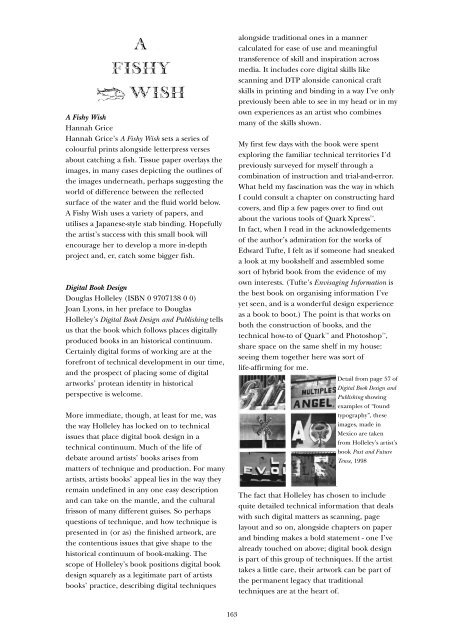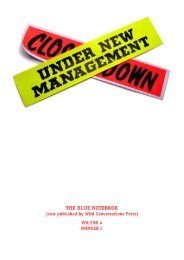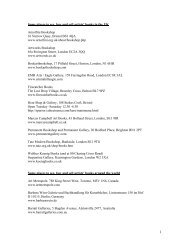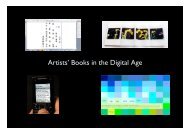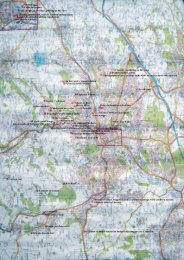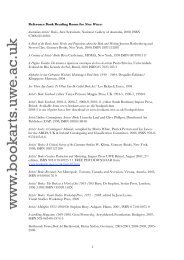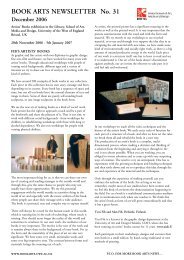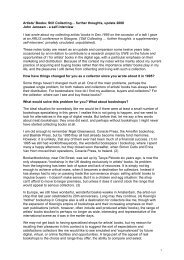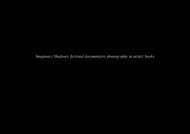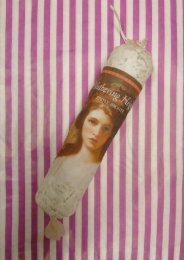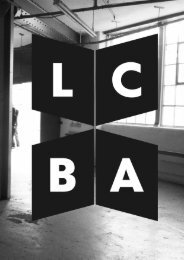Artist's Book Yearbook 2003-2005 - Book Arts - University of the ...
Artist's Book Yearbook 2003-2005 - Book Arts - University of the ...
Artist's Book Yearbook 2003-2005 - Book Arts - University of the ...
You also want an ePaper? Increase the reach of your titles
YUMPU automatically turns print PDFs into web optimized ePapers that Google loves.
A Fishy Wish<br />
Hannah Grice<br />
Hannah Grice’s A Fishy Wish sets a series <strong>of</strong><br />
colourful prints alongside letterpress verses<br />
about catching a fish. Tissue paper overlays <strong>the</strong><br />
images, in many cases depicting <strong>the</strong> outlines <strong>of</strong><br />
<strong>the</strong> images underneath, perhaps suggesting <strong>the</strong><br />
world <strong>of</strong> difference between <strong>the</strong> reflected<br />
surface <strong>of</strong> <strong>the</strong> water and <strong>the</strong> fluid world below.<br />
A Fishy Wish uses a variety <strong>of</strong> papers, and<br />
utilises a Japanese-style stab binding. Hopefully<br />
<strong>the</strong> artist’s success with this small book will<br />
encourage her to develop a more in-depth<br />
project and, er, catch some bigger fish.<br />
Digital <strong>Book</strong> Design<br />
Douglas Holleley (ISBN 0 9707138 0 0)<br />
Joan Lyons, in her preface to Douglas<br />
Holleley’s Digital <strong>Book</strong> Design and Publishing tells<br />
us that <strong>the</strong> book which follows places digitally<br />
produced books in an historical continuum.<br />
Certainly digital forms <strong>of</strong> working are at <strong>the</strong><br />
forefront <strong>of</strong> technical development in our time,<br />
and <strong>the</strong> prospect <strong>of</strong> placing some <strong>of</strong> digital<br />
artworks’ protean identity in historical<br />
perspective is welcome.<br />
More immediate, though, at least for me, was<br />
<strong>the</strong> way Holleley has locked on to technical<br />
issues that place digital book design in a<br />
technical continuum. Much <strong>of</strong> <strong>the</strong> life <strong>of</strong><br />
debate around artists’ books arises from<br />
matters <strong>of</strong> technique and production. For many<br />
artists, artists books’ appeal lies in <strong>the</strong> way <strong>the</strong>y<br />
remain undefined in any one easy description<br />
and can take on <strong>the</strong> mantle, and <strong>the</strong> cultural<br />
frisson <strong>of</strong> many different guises. So perhaps<br />
questions <strong>of</strong> technique, and how technique is<br />
presented in (or as) <strong>the</strong> finished artwork, are<br />
<strong>the</strong> contentious issues that give shape to <strong>the</strong><br />
historical continuum <strong>of</strong> book-making. The<br />
scope <strong>of</strong> Holleley’s book positions digital book<br />
design squarely as a legitimate part <strong>of</strong> artists<br />
books’ practice, describing digital techniques<br />
163<br />
alongside traditional ones in a manner<br />
calculated for ease <strong>of</strong> use and meaningful<br />
transference <strong>of</strong> skill and inspiration across<br />
media. It includes core digital skills like<br />
scanning and DTP alonside canonical craft<br />
skills in printing and binding in a way I’ve only<br />
previously been able to see in my head or in my<br />
own experiences as an artist who combines<br />
many <strong>of</strong> <strong>the</strong> skills shown.<br />
My first few days with <strong>the</strong> book were spent<br />
exploring <strong>the</strong> familiar technical territories I’d<br />
previously surveyed for myself through a<br />
combination <strong>of</strong> instruction and trial-and-error.<br />
What held my fascination was <strong>the</strong> way in which<br />
I could consult a chapter on constructing hard<br />
covers, and flip a few pages over to find out<br />
about <strong>the</strong> various tools <strong>of</strong> Quark Xpress .<br />
In fact, when I read in <strong>the</strong> acknowledgements<br />
<strong>of</strong> <strong>the</strong> author’s admiration for <strong>the</strong> works <strong>of</strong><br />
Edward Tufte, I felt as if someone had sneaked<br />
a look at my bookshelf and assembled some<br />
sort <strong>of</strong> hybrid book from <strong>the</strong> evidence <strong>of</strong> my<br />
own interests. (Tufte’s Envisaging Information is<br />
<strong>the</strong> best book on organising information I’ve<br />
yet seen, and is a wonderful design experience<br />
as a book to boot.) The point is that works on<br />
both <strong>the</strong> construction <strong>of</strong> books, and <strong>the</strong><br />
technical how-to <strong>of</strong> Quark and Photoshop ,<br />
share space on <strong>the</strong> same shelf in my house:<br />
seeing <strong>the</strong>m toge<strong>the</strong>r here was sort <strong>of</strong><br />
life-affirming for me.<br />
Detail from page 57 <strong>of</strong><br />
Digital <strong>Book</strong> Design and<br />
Publishing showing<br />
examples <strong>of</strong> “found<br />
typography”, <strong>the</strong>se<br />
images, made in<br />
Mexico are taken<br />
from Holleley’s artist’s<br />
book Past and Future<br />
Tense, 1998<br />
The fact that Holleley has chosen to include<br />
quite detailed technical information that deals<br />
with such digital matters as scanning, page<br />
layout and so on, alongside chapters on paper<br />
and binding makes a bold statement - one I’ve<br />
already touched on above; digital book design<br />
is part <strong>of</strong> this group <strong>of</strong> techniques. If <strong>the</strong> artist<br />
takes a little care, <strong>the</strong>ir artwork can be part <strong>of</strong><br />
<strong>the</strong> permanent legacy that traditional<br />
techniques are at <strong>the</strong> heart <strong>of</strong>.


